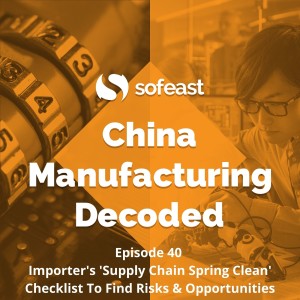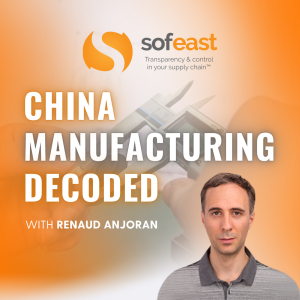
Adrian and Renaud, Sofeast's CEO, return in this special Chinese New Year 2021 edition of the podcast! 🧧🧨🐂
During the CNY period manufacturing in China (and other parts of East Asia) is effectively on hold for several weeks, so during this time importers have a chance to 'Spring Clean' their supply chain, finding and eliminating risks and also looking for untapped opportunities to make improvements, costs savings, and more.
So, based on his decades of experience in dealing with Asian suppliers, here's an interesting checklist from Renaud for you to work through over these few weeks.
Show Notes00:00 - Introducing the episode - why now is a good time to 'spring clean' your supply chain
02:52 - Risks associated with your current supplier base - too concentrated in 1 country, no backup suppliers for key components/products, near-shoring an option? etc...
08:01 - Is assembly closer to home using Chinese components a workaround for importers who want to move some of their supply chains out of China? If substantial transformation takes place you can say products are 'made in' another country other than China which could be beneficial, but a very long and complex supply chain also has its own issues as we discuss...
11:37 - Consolidate and strengthen relationships with key suppliers - few key suppliers rather than many, and managing them differently - more hands-on management, helping improve operations, etc. Giving talented suppliers (new or current) with R&D capabilities more business and co-developing new products with them helps you to gain closer relationships and can help form exclusive relationships with great suppliers. IKEA, for example, also sends in engineers to help their key suppliers 'level up' and improve quality etc, so this is another way to strengthen relationships.
16:40 - Rank & yank: what about replacing the lowest-performing factory every year? - grade suppliers based on their results and capabilities and encourage some turnover amongst the poorest performers. Why you need to take a zero-tolerance approach to a supplier with a history of poor performance.
20:34 - Why are many importers are reluctant to get rid of poor suppliers? - discussing why importers often fear the upheaval of switching to new suppliers.
22:58 - Do you have legal agreements in place with suppliers? - if a legal and enforceable manufacturing agreement/contract is in place importers shouldn't need to fear switching suppliers as much. If you didn't put such an agreement in place it's not always too late, Renaud gives some tips on how to reason with your supplier and persuade them to sign one.
25:44 - Does your onboarding process for new suppliers need to be tweaked to encourage the signing of manufacturing agreements? - based on past experiences with manufacturing agreements (or lack of) you can plan how to make new suppliers sign one as a standard process in future. This can also work with current suppliers, where they can be persuaded to sign one with the promise of new orders if they do so. It's imperative that the contract is enforceable in your supplier's country.
29:15 - Transparency into the supply chain? - do you buy from companies who do only final assembly, not creating much real value, but you stick with them because they have the contacts of the key component suppliers? This is a lack of transparency in your supply chain. There are ways to work on getting those key suppliers' contacts from these suppliers and then set up a parallel supply chain that you control, as well as finally cutting away the deadwood as we discuss here.
32:45 - Redesign of key products for better durability & reliability - taking information from users of the products in the field about failures and using it to redesign the production process, change a secondary material, or something actually fairly simple in order to produce a far better product. Doing this is often left on the 'back-burner' until a V2.0 or V3.0 of the product.
35:07 - Do you collect and use data about quality issues, returns, complaints, etc? - setting up a database and analyzing the trends and key issues is a good idea. Performing failure analysis on these will help you improve. This is a commonly missed opportunity for many importers.
36:53 - Do you have a structured NPI process in place if you're developing new products in order to reduce risks without adding much time & cost? - letting a factory rush to production, as Chinese suppliers often like to do, increases your risks, especially for new and complex products. Implementing a structured process will reduce the chances of nasty surprises during production.
39:08 - Local teams for sourcing: are they working hard enough to find new sources? - can they be incentivised somehow to become hungrier to find better new suppliers?
39:40 - Local teams for QC: are they competitive with external QC agencies? Do they work smarter over the years? - it may be that the cost of outsourcing QC to an external inspection provider compares favorably with that of your internal team and leads to less stress. Using an app to reduce paperwork and improve productivity could be something to consider for your inspection team, too.
41:02 - Inventory management - is it time to make better decisions based on risks of disruption based on the risk each individual supplier creates? This can be assessed using data to help you make decisions on how much inventory you truly need.
41:42 - Using an ERP or other IT systems to improve how you manage your business? - maybe it's time to explore what other companies use to manage their key numbers and people.
42:15 - Wrapping up
Related content...
- Rank & Yank - 7 Reasons To Switch To A New Chinese Manufacturer
- Enforceable Chinese manufacturing contracts - How To Create A Valid Manufacturing Contract In China To Protect Your IP
- Sofeast can help you to create an enforceable manufacturing agreement
- Data collection about returns etc - Investigating the Causes of Product Failure and Improving Design
- Improving your NPI process - New Product Introduction Process Guide For Hardware Startups
- External product inspections
- Quality inspection app to improve inspector performance - we use our app: SynControl
- Inventory management - How Much Inventory Do You Need?
- We've generally discussed risk reduction in the supply chain, so you will also like this series of blog posts on supply chain risks management that Renaud wrote, which includes topics like what black swan events like the pandemic could be described as being, business continuity planning, the benefits of supply chain scorecards, and more.
- Connect with us on LinkedIn
- Send us a tweet @sofeast
- Prefer Facebook? Check us out on FB
- Contact us via Sofeast's contact page
- Visit our website at Sofeast.com
- Subscribe to our YouTube channel
There are more episodes to come, so remember to subscribe! You can do so in your favorite podcast apps here:
- Apple Podcasts
- Spotify
- Stitcher
- Google Podcasts
- TuneIn
- Deezer
- iHeartRADIO
More Episodes
 2021-11-26
2021-11-26
 217
217
 2021-11-19
2021-11-19
 218
218
 2021-09-24
2021-09-24
 206
206
 2021-09-10
2021-09-10
 211
211
 2021-08-20
2021-08-20
 252
252
 2021-08-13
2021-08-13
 225
225
Create your
podcast in
minutes
- Full-featured podcast site
- Unlimited storage and bandwidth
- Comprehensive podcast stats
- Distribute to Apple Podcasts, Spotify, and more
- Make money with your podcast
It is Free
- Privacy Policy
- Cookie Policy
- Terms of Use
- Consent Preferences
- Copyright © 2015-2024 Podbean.com






